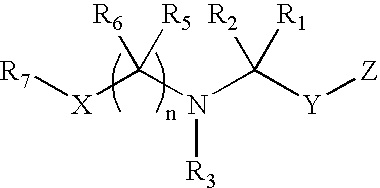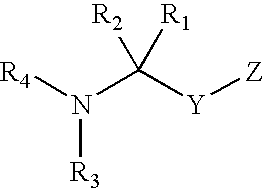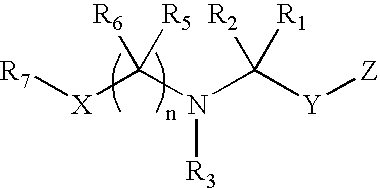Dipeptidyl peptidase inhibitors
a technology of peptide inhibitors and peptides, which is applied in the direction of drug compositions, immunological disorders, metabolism disorders, etc., can solve the problems of short half-life of glp-1 (7-36), infertility and amenorrhea,
- Summary
- Abstract
- Description
- Claims
- Application Information
AI Technical Summary
Benefits of technology
Problems solved by technology
Method used
Image
Examples
example 1a
1-(2-Bromo-acetyl)-(S)-pyrrolidine-2-carbonitrile
[0413] 13
[0414] To a cold solution (-10.degree. C.) of bromoacetyl bromide (2.0 g, 10.0 mmol) in CH.sub.2Cl.sub.2 (30 mL), a solution of (S)-pyrrolidine-2-carbonitrile (480 mg, 5.0 mmol) and pyridine (1.4 g, 210 mmol) together with a catalytic amount of DMAP (50 mg) in CH.sub.2Cl.sub.2 (10 mL) was added over a 30 minute period. After stirring for about 10 minutes, the reaction temperature was gradually increased to room temperature. Stirring at room temperature was continued overnight. The residue was diluted with CH.sub.2Cl.sub.2 (60 mL), washed with ice water and cold 10% sodium bicarbonate aqueous solution to give crude product (1.01 g; yield of 93%). Column chromatography purification of the crude product resulted in pure 1-(2-bromo-acetyl)-(S)-pyrrolidine--2-carbonitrile (892 mg; 82.6% yield).
Example 1
B: 1-[(S)-2-Amino-4-methyl-pentanoyl]-(S)-pyrrolidine-2-carboxylic acid amide
[0415] 14
[0416] To a solution of (S)-2-tert-butoxycar...
example 1
1 (S)-2-[2-(2-Cyano-pyrrolidin-1-yl)-2-oxo-ethylamino]-(S).sub.4-methyl-pe-ntanoyl}-(S)-pyrrolidine-2-carboxylic acid amide
[0417] 15
[0418] A solution of 1-(2-bromo-acetyl)-(S)-pyrrolidine-2-carbonitrile (44 mg, 0.2 mmol) in THF (1 mL) was added slowly to a cold solution (-15.degree. C.) of 1-(2-amino-4-methyl-pentanoyl)-pyrrolidine-2-carboxyl-ic acid amide (55 mg, 0.24 mmol) in THF (2 mL). The temperature of the reaction mixture was gradually increased to room temperature. After stirring at this temperature overnight, the residue was concentrated and purified by LCMS to yield 1{(S)-2-[2-(2-Cyano-pyrrolidin-1-yl)-2-oxo-ethy-lamino]-(S)-4-methyl-pentanoyl}-(S)-pyrrolidine-2-carboxylic acid amide (54 mg; 62%). This pure product (20 mg) was dissolved in THF (1 mL), HCl ether (0.1 mL; 2M) was added and the mixture was concentrated to give the HCl salt form of 1-{(S)-2-[2-(2-cyano-pyrrolidin-1-yl)-2-oxo-ethylamino]--(S)-4-methyl-pentanoyl}-(S)-pyrrolidine-2-carboxylic acid amide. .sup.1H-...
example 2
1-{(S)-2-[2-(2-Cyano-pyrrolidin-1-yl)-2-oxo-ethylamino]-acetyl}-(S)-pyrrol-idine-2-carbonitrile
[0419] 16
[0420] To a solution of Boc-iminodiacetic acid (115 mg, 0.5 mmol) and (S)-pyrrolidine-2-carbonitrile (106 mg, 1.1 mmol) in CH.sub.2Cl.sub.2 (5 mL) was added DMAP (20 mg) and EDCI (360 mg, 1.2 mmol). After overnight stirring at room temperature, the residue was diluted with CH.sub.2Cl.sub.2 (20 mL), washed with water (twice), 10% HCl aqueous solution and water, and concentrated. The crude product was further treated with 50% TFA in CH.sub.2Cl.sub.2 (5 mL) at room temperature for 30 minutes, concentrated to dryness, and purified by LCMS to give the TFA salt form of 1-{(S)-2-[2-(2-Cyano-pyrrolidin-1-yl)-2-oxo-ethylamino]-acet-yl}-(S)-pyrrolidine-2-carbonitrile (136 mg) in 70% yield. .sup.1H-NMR data (CDCl.sub.3-CD.sub.3OD, 20:1): .delta., 4.79 (dd, 2H, J=5.2 and 5.7 Hz), 4.2 (ABq, 4H, J=6.18 Hz), 3.61 (m, 2H), 3.48 (m, 2H), 2.1-2.3 (m, 8H). MS (ES) [m+H] / z calculated for C.sub.14H.su...
PUM
| Property | Measurement | Unit |
|---|---|---|
| diameter | aaaaa | aaaaa |
| height | aaaaa | aaaaa |
| temperature | aaaaa | aaaaa |
Abstract
Description
Claims
Application Information
 Login to View More
Login to View More - R&D
- Intellectual Property
- Life Sciences
- Materials
- Tech Scout
- Unparalleled Data Quality
- Higher Quality Content
- 60% Fewer Hallucinations
Browse by: Latest US Patents, China's latest patents, Technical Efficacy Thesaurus, Application Domain, Technology Topic, Popular Technical Reports.
© 2025 PatSnap. All rights reserved.Legal|Privacy policy|Modern Slavery Act Transparency Statement|Sitemap|About US| Contact US: help@patsnap.com



